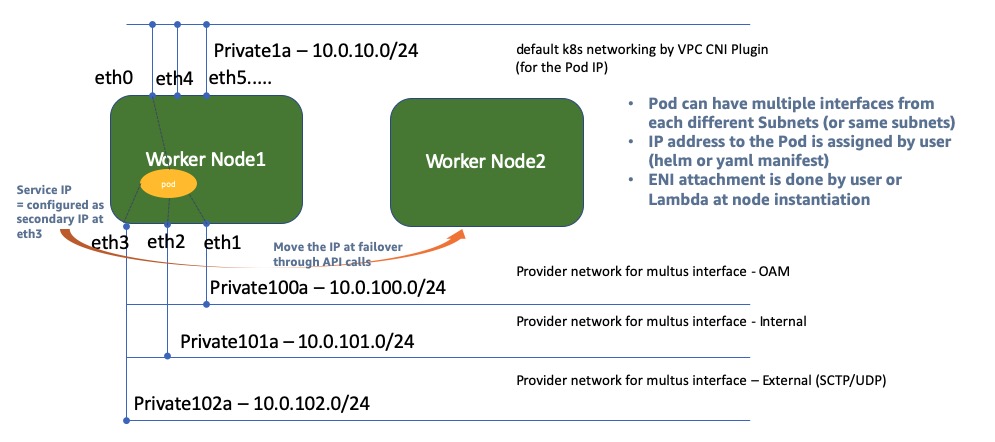----------------------------------------------------------------------------------------------------------------
[Important Notice]
[Aug.2021] Please also erfer to official guiding references.
- https://aws.amazon.com/blogs/containers/amazon-eks-now-supports-multus-cni/
- https://docs.aws.amazon.com/eks/latest/userguide/pod-multiple-network-interfaces.html
- https://github.com/aws-samples/eks-install-guide-for-multus/blob/main/README.md
----------------------------------------------------------------------------------------------------------------
(a.k.a. Multus CNI Plugin with EKS/VPC CNI Plugin)
This is the CloudFormation template for self-managed worker node creation with Multus CNI plugin in EKS. In case of Telecom network function implementation on AWS EKS environment, multus meta-CNI plugin is frequently being requested to make Pod to have multi-homed interfaces(https://github.com/intel/multus-cni). In AWS environment, to use this multus CNI plugin along with VPC CNI plugin, workernode group has to attach multiple interfaces with making those interfaces not to be managed by VPC CNI plugin. This CloudFormation template for self-managed worker node group is to create workernode instances for EKS with having secondary interfaces without being managed by VPC CNI Plugin. As a result of CFN, workernode will spin off with having 1st interface to be VPC CNI controlled default K8s networking and 2nd (3rd, 4th as defined) interface to be for multus interfaces. (If VPC CNI requires more ENIs for assigning Pod IP address, then it attaches more ENIs after multus interfaces in order).

See CONTRIBUTING for more information.
This library is licensed under the MIT-0 License. See the LICENSE file.
-
May. 2021 (major change in Lambda for IPv6 support).
- CFN and Lambda updated to have flexible input number of Multus Subnets and Security Group. (list of subnets/security-groups)
- IPv6 support for multus subnets (VPC and target multus subnet should be enabled with IPv6 assignment in advance)
-
July.2024 (new CFN templates updated in the repo).
- LaunchConfig is now updated to use LaunchTemplate.
- A new way to use userData to attach ENIs instead of using Lambda (refer to https://github.com/aws-samples/cfn-multus-eks-managed-ng )
- A new template for AL2023 added (AL2023 requires additional nodeadm config).
- This CFN assumes user already has created VPC, security groups and subnets for multus required networks (e.g. OAM, Signaling, Userplane).
- [Important Note] User must be aware of and responsible of that using this CFN and this mode of multus will cause the number of pods hosted on the workernode to be reduced down because this mode is dedicating certain number of ENIs only for Multus subnet purpose. (In general, a number of max Pods on the node has tight dependancy to the number of ENIs available for VPC CNI plugin.)
The initial Lambda based CFN worked in below way;
From the baseline CFN for self-managed node group, below functions are added;
- LifeCycle Hook creation for the self-managed workernode ASG.
- Lambda function creation for multus ENI attachment of 2ndary subnet (using the code (in zip file) pre-uploaded in S3). The lambda function supports multus subnets as many as defined in the CFN template with MultusSubnets list (as well as MultusSecurityGroupIds list). While attaching multus interfaces to the instance, also it adds "no_manage" tag to these interfaces so that these would not be controlled by VPC CNI Plugin.
- Number of additional Multus ENIs can be limited by the size of instance. (please refer to https://docs.aws.amazon.com/AWSEC2/latest/UserGuide/using-eni.html for more detail).
- CloudWatch Event Rule to trigger Lambda function.
- Automatic-reboot after the first creation of instance (only after the first creation of Autoscaling group), to kick in life-cycle hook to invoke Lambda for multus interface attachment.
But now, CFN updated to use only userData (API to be called inside of userData), which gives more straighforward and simple process than Lambda approach (this doesn't require initial-reboot event any further, which saves time to complete NG creation).
- Install the multus meta-cni plugin in your EKS.
kubectl apply -f https://raw.githubusercontent.com/aws/amazon-vpc-cni-k8s/master/config/multus/v3.7.2-eksbuild.1/aws-k8s-multus.yaml - Before running this CloudFormation, you have to place lambda_function.zip file (compress lambda_function.py to zip file in this github lambda folder) to your S3 bucket.
- During CFN stack creation
- Select primary private subnet(s) for the parameter of
Subetswhere the primary K8s networking interface would be connected to. - Select Multus subnet(s) for the parameter of
MultusSubnetswhere multus ENIs will be connected to, as the list of subnets. - Select security group for multus subnet(s). If each multus subnet requires each own security group, then please select same number of security groups with the number of multus subnets in same order. If the number of security group doesn't match with the number of multus subnets, then the first security group will be used for all multus subnets commonly.
- Select primary private subnet(s) for the parameter of
- After completion of stack creation, update aws-auth-cn.yaml with Node Role ARN in Output section of the CloudFormation result, to make workernodes to join the your EKS cluster.
- Once all workernodes come up with multiple ENIs as intended (please make it sure each multus subnet ENI has to be with "no_manage" tag) and also workernodes successfully join to your EKS cluster, then you can deploy an application that is with multus-cni network definition in following steps.
- NetworkAttachmentDefinition [example].
apiVersion: "k8s.cni.cncf.io/v1" kind: NetworkAttachmentDefinition metadata: name: ipvlan-conf spec: config: '{ "cniVersion": "0.3.0", "type": "ipvlan", "master": "eth1", "mode": "l2", "ipam": { "type": "host-local", "subnet": "10.0.100.0/24", "rangeStart": "10.0.100.71", "rangeEnd": "10.0.100.72", "routes": [ { "dst": "10.1.2.0/24" } ], "gateway": "10.0.100.1" } }'- Create an app with using this NetworkAttachmentDefinition (using ipvlan CNI plugin for multus interface) [example].
apiVersion: v1 kind: Pod metadata: name: samplepod annotations: k8s.v1.cni.cncf.io/networks: ipvlan-conf spec: containers: - name: samplepod command: ["/bin/bash", "-c", "trap : TERM INT; sleep infinity & wait"] image: nginx- In this example, we have to configure
10.0.100.71/24as the secondary IP of the multus ENI for the VPC networking. For this additional step app conatiner can configure this IP address to multus ENI through API call (please refer to the example python code for this atsamplecode/IpUpdateFromPod.py). This step can be integrated and automated using init-container or sidecar of the container. - Note If the application requires DPDK interface for the multus interface, then we can use host-device CNI plugin instead of ipvlan CNI plugin.